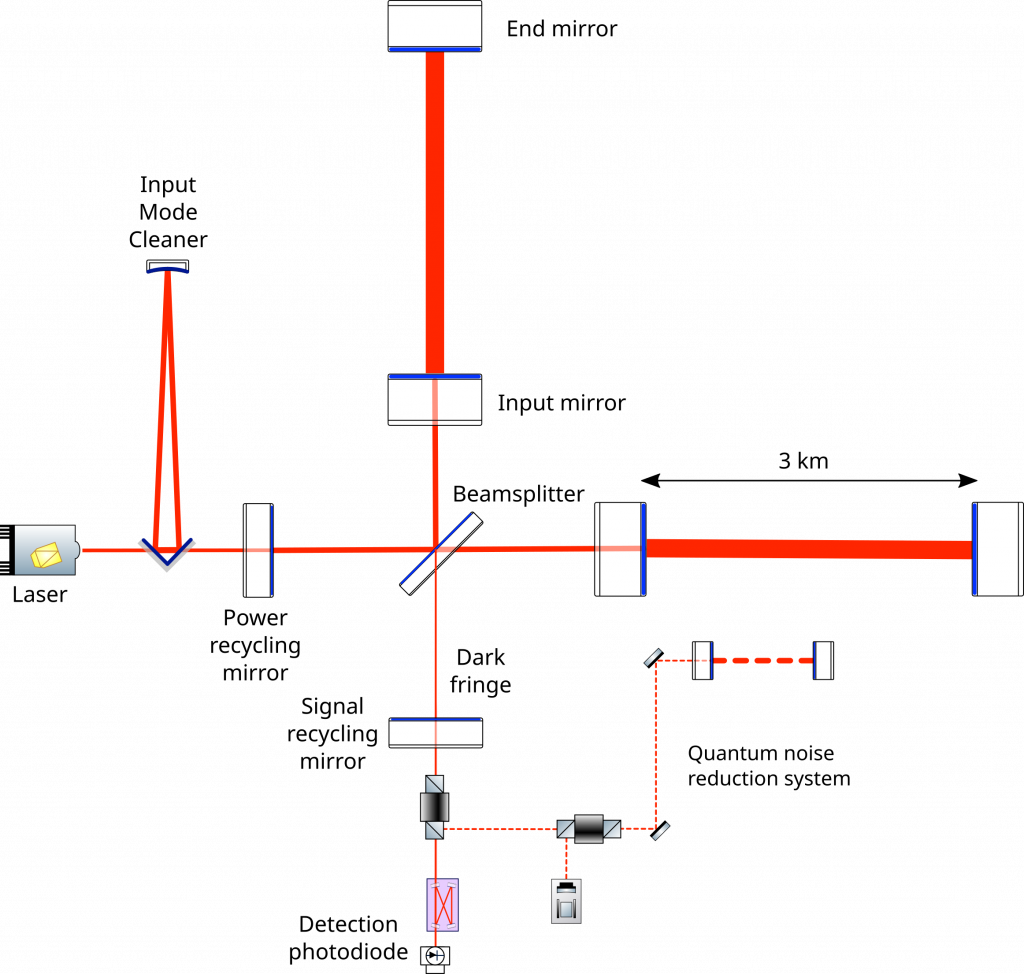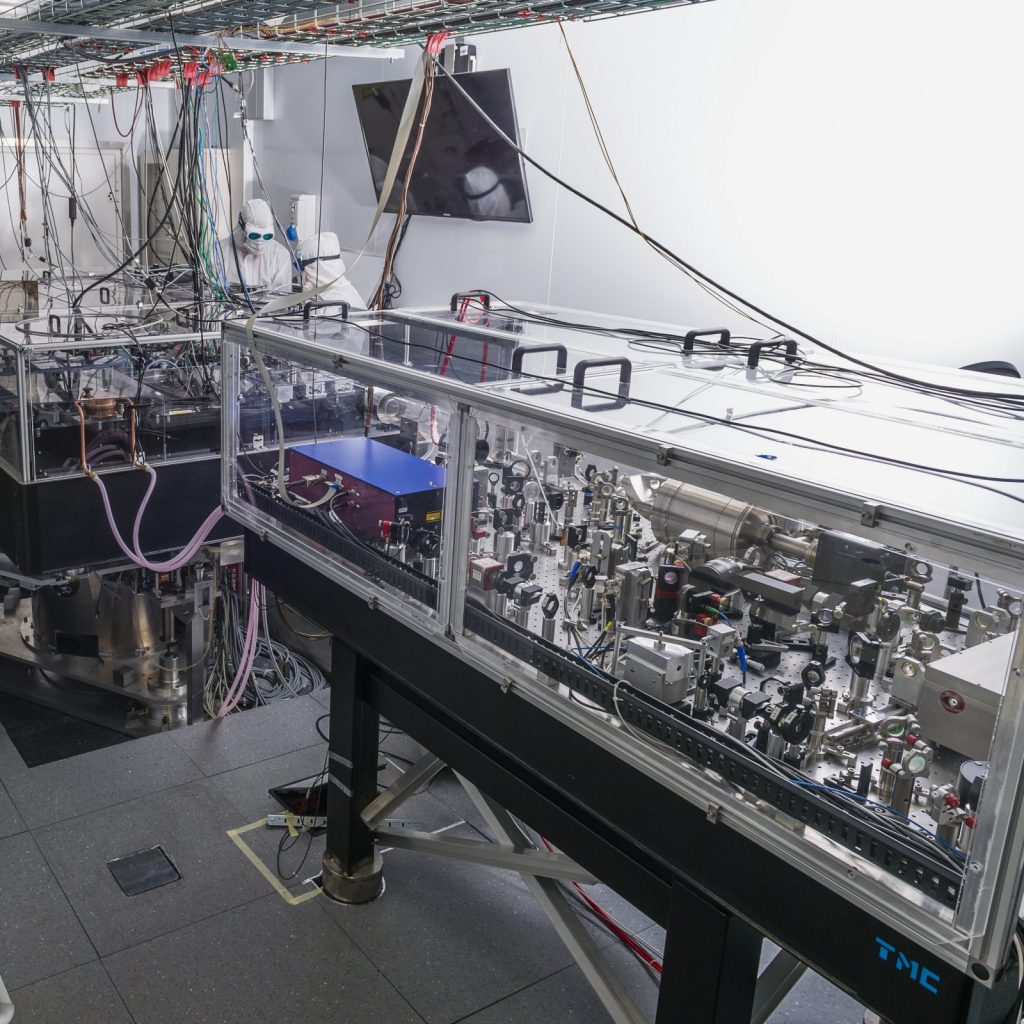Optical Layout
Advanced Virgo is a laser interferometer with 3 kilometers long perpendicular arms: this instrument and configuration is ideally suited to measure the tiny effect produced by gravitational waves passing through the detector: they alternatively shrink one arm while stretching the other one. The change in the arm lengths is proportional to the arm length itself, as well as to the wave amplitude: so to increase the signal it is preferable to have arms as long as possible. Advanced Virgo arms are built to be 3 kilometers long and then the laser path is folded hundreds of times before the light recombines at the beam splitter. This is achieved by implementing optical resonators (called Fabry-Perot cavities) along each arm by adding one extra mirror at the beginning of each arm, close to the beam splitter. Thus each arm has two mirrors: the input and the end one.
Because the interferometer works at ‘dark fringe‘, the light that is recombined by the beam splitter after traveling along the arms interferes constructively in the direction towards the laser source: instead of blocking such light, it is reflected back so that it is re-used in the interferometer: this is done thanks to an additional mirror placed downstream just before the beam-splitter. This is named Power Recycling mirror and the light power is said to be recycled. We ‘recycle’ also the gravitational wave signal: this is done by adding one more signal after the beam-splitter, before detecting the interference pattern. This mirror is named the Signal Recycling mirror. Overall, Advanced Virgo is designed to be a dual recycled Michelson interferometer.The Advanced Virgo optical layout comprises two additional systems: the Input Mode Cleaner and the Quantum Noise Reduction. The first one is needed to improve the quality of the laser beam circulating the interferometer, in terms of beam pointing stability, spatial shape, frequency purity. The second is a complex system to reduce the noises due to the quantum nature of light.

Injection

© Cyril Frésillon/Virgo/Photothèque CNRS
In Advanced Virgo the part of the detector which delivers the laser beam to the interferometer with the required power, size and stability is called ‘the injection’. It comprises all the parts between the infrared laser source (wavelength of 1μm) and the core interferometer and it ensures that the input laser beam will have all the right properties to be able control the interferometer with very low noise. One key element of the injection is the 150 m long optical cavity, called the Input Mode Cleaner’: its purpose is to guarantee a well-defined laser beam stable in position and shape. Finally, before the recycling cavities, a telescope will enlarge the laser beam by a factor 20 to match the required beam size in the central part of the detector.
Arm cavities
The two optical resonators which are along the perpendicular arms (and called the ‘arm cavities’) give Virgo its characteristic L-shape and are among the most critical components of the detector. Each of the arm cavity is formed by 2 outstanding mirrors, each 42 kg in mass, one at the input, close to the beam splitter, and one 3 km further which reflects all the light back towards the beam splitter. They are optical resonators in the sense that the light between the two mirrors propagates in multiple round trips, each time enhancing a little more the gravitational signal. For example, in Virgo, the gravitational wave signal is amplified by about a factor 300 thanks to the cavities in the arms.
To enhance the performance of the interferometer the surface of each mirror is polished at the atomic level, reducing the amount of scattered light. The coating on the mirror surface is also special to reflect all the light with very limited absorption and inducing no distortion. These mirrors have been (improperly) called the perfect optics. Thanks to the quality of the mirrors, the amount of laser light lost during one round trip in the cavity (so traveling 6 km) is less than 0.01%. More details here.
Detection
In Advanced Virgo the part of the detector which is responsible for extracting the signal encoded on the laser light by the gravitational wave, is called ‘the detection’. It also provides a large part of the signals to control the interferometer and keep it at its working point. As for other parts of Advanced Virgo, noise control is critical, so all the optical components for the detection are isolated from the ground motion by suspending the optical benches they sit on: these benches are hosted in vacuum to avoid dust and acoustic noise. At the output of the interferometer, a telescope is used to reduce the beam size by a factor 40 to achieve a laser size compatible with the photoreceivers, called photodiodes. A smaller optical cavity, called the ‘Output Mode Cleaner’, is inserted before the final photodiode where the gravitational wave signal is recorded. This cavity filters the light to remove spurious signals and only transmit the laser light which may contain the gravitational wave signal.